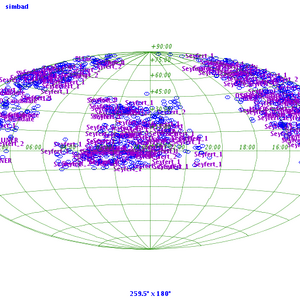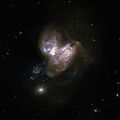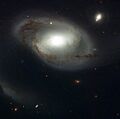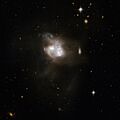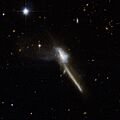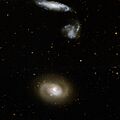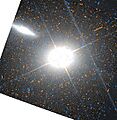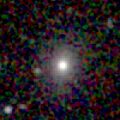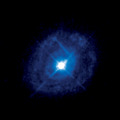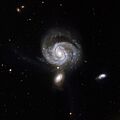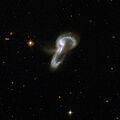Markarian galaxies facts for kids
Markarian galaxies are special galaxies that shine super brightly in ultraviolet light from their centers. Imagine a galaxy's heart glowing with extra UV light – that's a Markarian galaxy!
A scientist named Benjamin Markarian first noticed these unique galaxies in 1963. He saw that their central parts, called "nuclei," looked very blue. This blue color comes from very hot, bright stars. But this bright blue center was different from the rest of the galaxy.
Scientists also found that the light from these galaxies showed signs of lots of energy. This means something very active is happening in their cores! You might see them listed as "Markarian ####" or with abbreviations like Mrk, Mkr, or Mkn.
Contents
Discovering Markarian Galaxies
In 1964, Benjamin Markarian decided to actively search for these special galaxies. He wanted to find more of them!
The First Byurakan Survey
The big search began in 1965 at the Byurakan Astrophysical Observatory in Armenia. Scientists used a special Schmidt telescope for this project. This telescope was very powerful for its time. It had a large mirror and a unique prism. This setup helped them find galaxies that glowed extra brightly in ultraviolet light.
The telescope was designed to see blue and violet light very well. It could find galaxies that were quite dim, down to a brightness level of 17.5. Soon, 70 galaxies with strong ultraviolet light were found! This is when the name "Markarian galaxies" became popular.
By 1969, the list grew to 302 galaxies. The survey continued until 1978, and by 1980, scientists had finished studying all the images. Eventually, the list of Markarian galaxies from this first survey reached 1500!
The Second Byurakan Survey
Later, in 2005, a new project called the "Second Byurakan Survey" started. This survey looked for even fainter, or dimmer, objects. It created a huge list of 3563 objects! This included 1863 galaxies and 1700 stars. Many of these galaxies had very active centers, like Seyfert galaxies or quasars.
What Makes Markarian Galaxies Special?
When scientists listed these galaxies, they included details like their name, location in space, and how they looked.
How They Are Described
- Core Appearance: The center of each galaxy was described in two ways. It could be "s" for star-like, meaning it looked like a bright point of light. Or it could be "d" for diffuse, meaning it was more spread out. Sometimes, it was a mix, like "ds" or "sd."
- UV Brightness: A number (1, 2, or 3) showed how strong the ultraviolet light was. "1" meant very strong, "2" was moderate, and "3" was weak.
- Emission Lines: If the galaxy's light showed special "emission lines" (telling scientists about gases), an "e" was added.
Sometimes, a blue star in front of a galaxy made it seem like a Markarian galaxy, even if it wasn't. Also, a few galaxies were accidentally listed more than once!
Types of Markarian Galaxies
The Markarian catalogue includes many exciting types of objects:
- Seyfert galaxies: These have very bright, active centers, often powered by a supermassive black hole.
- Starburst galaxies: These are galaxies where new stars are forming at an incredibly fast rate.
- H II regions: These are huge clouds of glowing gas where new stars are being born. Some Markarian objects are actually these bright regions within a galaxy!
- Active galactic nuclei (AGN): This is a general term for galaxies with very bright, active centers.
- Quasars: These are extremely bright and distant objects, thought to be powered by supermassive black holes.
Some Markarian galaxies have giant black holes at their centers. These black holes can shoot out powerful jets of hot gas! Many of these galaxies also change in brightness. This tells us their powerful light comes from a very small, active area.
Gallery


